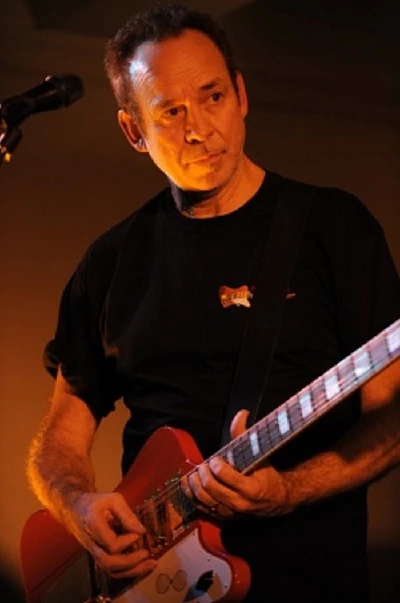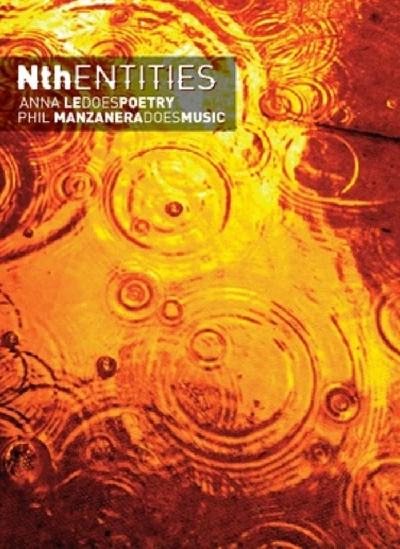published: 16 /
4 /
2012

Roxy Music guitarist Phil Manzanera chats to Lisa Torem about his new album with poet Anna Le. 'Nth Entities: Phil Manzanera Does Music, Anna Le Does Poetry'
Article
Phil Manzanera played lead guitar with Roxy Music from 1971 to 1983. During this time, he contributed co-writes to ‘Stranded’ (1973), ‘Country Life’ (1974), ‘Siren’ (1975), ‘Manifesto’ (1979), ‘Flesh and Blood’ (1980) and ‘Avalon’ (1982). In addition, he co-produced ex-Pink Floyd guitarist David Gilmour’s 2006 solo album, ‘On an Island’. Manzanera’s acclaimed instrumental album, ‘Firebird VII’, was released in 2008. Like his former Roxy Music colleague, Brian Eno, his mission seems to be to push the musical envelope and use instrumental work as a foundation for creative experimentation.
With Roxy Music, Manzanera came back, full force, after a hiatus, to complete a 52-date world tour in 2001. He has since then continued to tour sporadically and play with the band since, but during his time away from the band he kept himself busy with a multitude of creative projects, including working with Columbian artist/sculptor, Lucho Brieva, on the 2010 album, ‘Corroncho’. This album incorporated many of the sounds he was exposed to in his youth: salsa, cumbia and pop; Manzanera’s family lived in many Latin American countries and these influences greatly impacted his worldview.
As a young boy, he played Cuban folk songs which were inspired by the Cuban revolution, so his first encounter with poet Anna Le, at an event at which revolutionary thought was expressed openly amongst artists, proved to be prophetic and has led to their album, ‘Nth Entities: Phil Manzanera Does Music, Anna Le Does Poetry’ on his Expression Records label.
Manzanera explains how the project came about and why his partnership with Le has generated such enthusiasm, although both artists specialize in different mediums.
PB: The idea behind collaborating with poet, Anna Le, was suggested by Charles Shaar Murray, the Jimi Hendrix biographer, during a ‘Talking Music Revolutions’ event, at which Anna read her poem, ‘Jimi’. Did you take to this idea immediately or did you initially have reservations about featuring poetic text with your instrumentals? In other words, did you feel confident that your compositions and Le’s poetry would stand on their own, and reflect your individual voices, despite the partnership?
PM: When Charles first mentioned the idea at the Jimi Hendrix, I just nodded in appreciation of his suggestion, but didn’t really think anymore about it. I was reminded some months later about the idea and decided to have a go, because it was a challenge and something I’d never done before. I am always looking for new adventures in music.
I decided to ring Anna and ask her to come to the studio and read me some of her poems, as at this point I’d only heard ‘Jimi’. I recorded her reciting the poetry, and then began the process of seeing whether I could write some music for them. I initially played back her words from my laptop, and got out an acoustic guitar and just played anything that came to me and recorded it on my phone.
Then I listened back to it and I thought, “This has got potential”, and I found that she had a natural rhythm which I could lock in to, so I went to my recording studio, and with the aid of Mike Body, the engineer, I started to construct a fuller musical picture. And that’s how all the tracks were done, me reacting to Anna’s spoken words and the meanings of her poems. The idea was to blend Anna’s words into my musical context.
PB: Three music giants, Lee Scratch Perry, Stevie Wonder, and, of course, Jimi Hendrix are featured on the album via spoken word. Was there a specific reason that Anna Le focused in on these artists?
PM: She was asked to write poems for three ‘Musical Revolutions’ evenings about these musicians.
PB: ‘Lego Limbos’ is probably the most humorous piece, as Anna elaborates on the clumsiness of romance. It starts out acoustically as opposed to many of the other hard-hitting arrangements. This is another reason this track is different. Did you have a visual picture in your mind when you wrote this?
PM: I had a very strong feeling that it needed a ‘early-Dylan-type context,’ but because I started strumming on an acoustic guitar it seemed appropriate that it went from the phone idea to the recording studio. I then made it even more Dylan/Neil Young by adding the harmonica and Hammond organ.
PB: In ‘My Nth Entities’, Le says, “I’m many rivers…I’m dirty puddles and salty seas. I’m natural streams…” over a thunderous bass line. Of all the tunes, this one creates the most heightened sense of hysteria. Do you plan to perform songs like this onstage, and, if so, will you perform them as set or improvisational pieces, based on the audience response?
PM: We are definitely planning this live and there will be an element of improvisation.
PB: Thank you.
Please include the strap line:
‘Nth Entities: Phil Manzanera Does Music, Anna Le Does Poetry’ is available online from http://expressionrecords.com/shop/index.php?maincat_id=26
Picture Gallery:-
